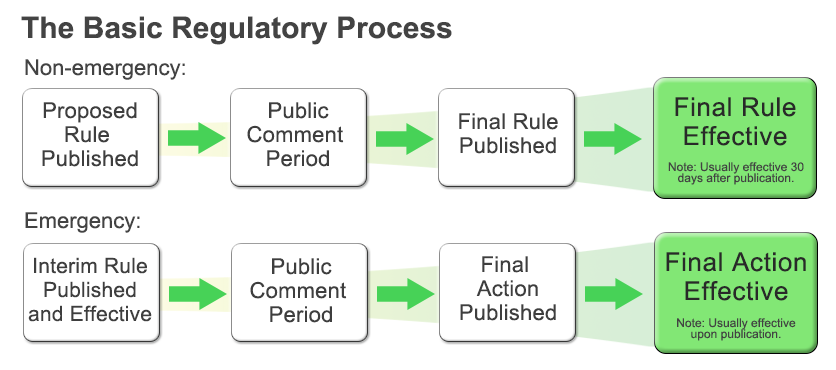Lesson 3: Basic Requirements of the U.S. Regulatory System
Topic 1: The Administrative Procedure Act
The basic statute governing U.S. rulemaking is the Administrative Procedure Act. Its basic requirements are described and explained here.
Objective:
- Identify the requirements the Administrative Procedure Act imposes on administrative procedures and describe the intent and benefits of those requirements
The principal statute governing the U.S. rulemaking process is the Administrative Procedure Act (APA). The APA was enacted in 1946 and ensures that agencies obtain input from the public before implementing new rules, with limited exceptions for emergencies. This statute applies to all agencies in the U.S. government, not just APHIS. In addition to fulfilling its commitments under the SPS Agreement, APHIS’ rules must be promulgated in accordance with the APA.

The APA establishes several principal requirements for rulemaking. The APA defines a “rule” as “the whole or a part of an agency statement of general or particular applicability and future effect designed to implement, interpret, or prescribe law or policy or describing the organization, procedure, or practice requirements of an agency.”
In simpler terms, if an agency wants to put in place a requirement that will apply in the future either to everyone or to specific parties, it has to follow the requirements of the APA.
The APA requires agencies to publish a notice of proposed rulemaking in the Federal Register, so that anyone affected by or interested in the rule can have access to the rule. Agencies must then allow for public comment on the rule. We will discuss the Federal Register in detail later in this lesson.
After the public comments have been received and considered by the agency, the agency may publish a final action. The final action discusses the comments the agency received and, if appropriate, makes changes to the proposed rule or interim rule based on the comments. The APA specifies that the effective date of this final action must be at least 30 days after publication, unless the final action is lessening restrictions, or there exists some other good cause to make the action effective sooner. This requirement reflects Congress’ judgment that, when a new rule adds restrictions, it is important to give affected entities time to comply with the new requirements.
The APA only permits agencies to publish rules that are effective immediately when good cause exists, such as an emergency situation. APHIS refers to such actions as “interim rules”, though other agencies call them “interim final rules”.
For example, if a new pest that affects tomatoes is discovered, APHIS might issue an interim rule to impose new requirements on imported tomatoes to prevent the introduction of this pest. We will discuss the process to update existing sanitary and phytosanitary restrictions in more detail in Lesson 6 of this module.
Regardless of the action being taken, all agency rulemaking must comply with the Administrative Procedure Act. The basic requirements of the APA are public notice, an opportunity to comment, and an effective date set after publication of the final action in most cases.
To continue, select Topic 2 from the Topics menu above or click here.